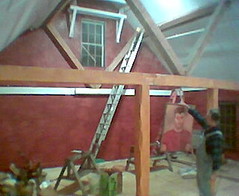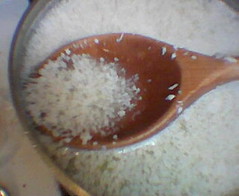more milk paint went up today. gabriel helped me out taking care of the goldenrod while i painted red. i'm getting better at formulating the paint. here's what i've found.
for about a quart of paint do the following:
- heat one gallon of skim milk to room temperature or a little warmer, either on a stove or by leaving it out a while. make sure not to overheat it or you will get big sticky curds! heat to no warmer than body temperature, so if it feels hot when you stick your finger in it's probably too hot.
- once the milk reaches room temperature, add 1 cup of white vinegar, pouring it slowly into the milk while stirring. or: 1tbsp vinegar per cup skim milk.
- when the last bit of vinegar goes in, you will notice the milk suddenly change from opaque to clear with curds (see picture).
- let the curds stand for a few minutes stirring occasionally. i'm not sure this does anything, but i do it. the recipies i first tried from books said to let the curds stand overnight. i haven't found that letting them sit overnight produces any nicer curds. but, what do i know?
- prepare a collander with cheesecloth, muslin or paint strainer (what i use) and place in your sink.
- pour the milk/vinegar mix into the cheesecloth and allow the curds (white stuff) to separate from the whey (clear stuff). it's important to find cheesecloth that's fine enough not to let your curds go down the drain. the curds will not be very big, so something like stocking mesh works well. the first batch i did all my curds fell through the cheesecloth.
- let the curds drain until there's little liquid coming from them
- i place the curds now into a blender, with a bit of water to start and puree them. be careful not to overload your blender with curd! lubricate the curds by adding water when the mix stops spinning. the curd can turn very rubbery around the spindle and stop the blender altogether if you don't keep enough water in the mix--not good for the mixer. after adding all the curds and water, puree for a few minutes. this will entrain a fair amount of air into the mix, but the bubbles work themselves out while painting.
- you should have about a quart of milk paint base when you're finished.
- next add pigment. i add between one and two tablespoons of pigment per cup, depending on how much transparency i want. one tablespoon gives a heavy stain look while two makes fairly opaque paint.



No comments:
Post a Comment